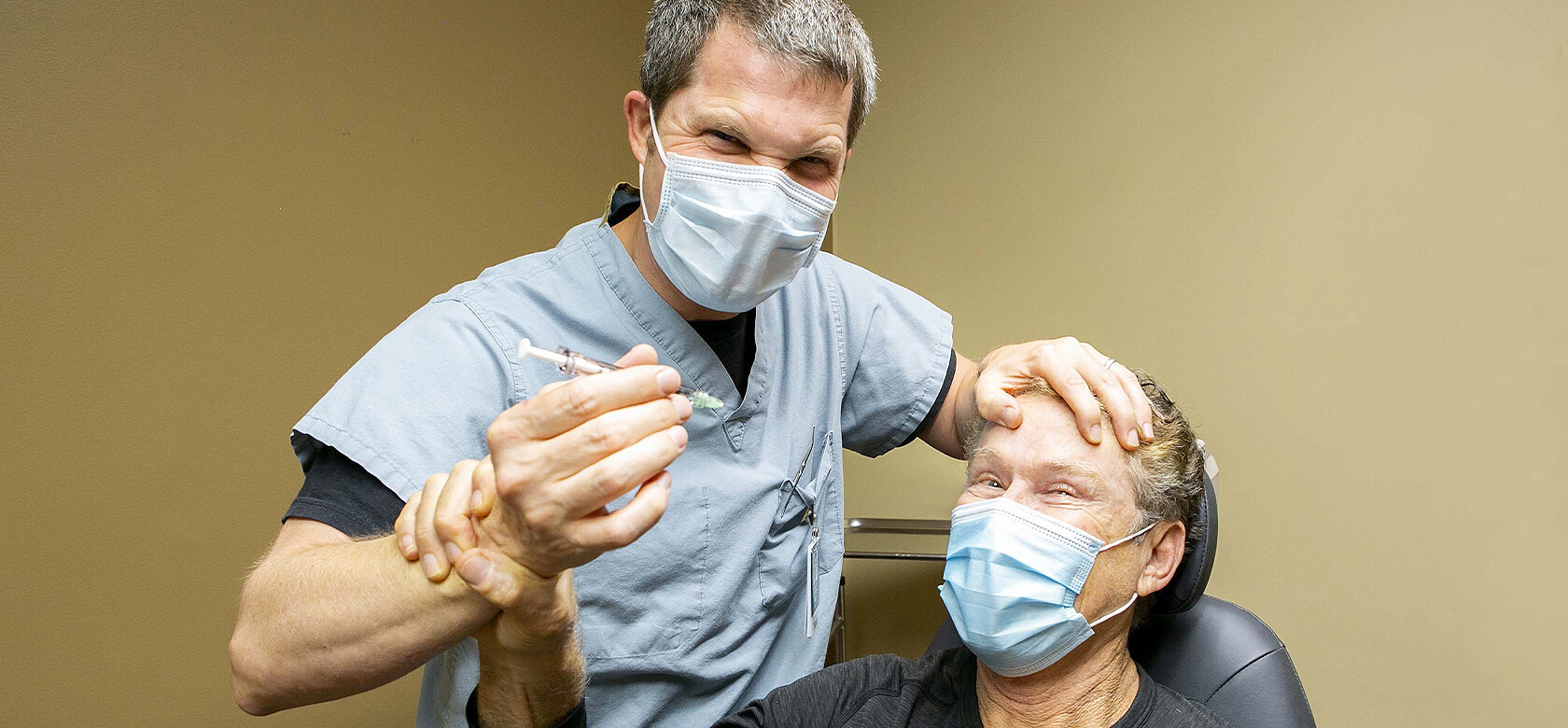Before getting started, read our Retina 101 page.
Why do I need an intraocular injection?
Over the past 15 years, our ability to treat blinding retinal conditions has grown immensely. We now have the power to inhibit the growth of dangerous blood vessels as well as shut down leakage from damaged blood vessels. We can also deliver highly-potent antibiotics and steroids to combat inflammation and infections. These can be vision-saving. For many retinal diseases, the only way to safely deliver a high dose of the medication into the eye is through an injection – drops simply don’t deliver enough medication to the inside of the eye, and pills or systemic medications would have far too great side effects.

While the idea of getting an injection in the eye can be terrifying, if done right in the vast majority of cases they are essentially painless. The most common sensation is a slight burning sensation that is related to the antiseptic used to clean the surface of the eye. At RCSD we go to great lengths to make the injections as painless as possible and often get compliments from snowbirds who receive injections elsewhere. We also try hard to minimize post-injection pain with appropriate drops and are researching the use of amniotic membrane contact lenses to provide durable pain relief with exciting initial results.
Intraocular injections are very quick and are performed through the white part of the eye, called the sclera. There are three critical steps in performing injections: 1. The injections must be performed in the correct location, where the needle will not damage any of the delicate structures of the eye; 2. The eye must be numbed to minimize or eliminate pain; and 3. The surface of the eye must be disinfected to minimize the risk of infection. Injections are most often performed in the office in a standard exam room. The eye is numbed with drops, followed by a cotton swab with concentrated lidocaine, followed by a small numbing injection per protocol of your physician. Once the eye is numb, the doctor will lean you back and ask you to look in a certain direction. They may use a lid speculum, if needed, to help keep you from blinking. After a few drops of an iodine solution are applied to the surface of the eye, the doctor will perform the injection with a tiny needle and then wash the antiseptic to minimize any burning.
While intraocular injections are extremely safe, there are important risks to be aware of, risks we try very hard to minimize. Most of the common side effects are minor and include bruising on the eye, discomfort, and new floaters which are most often temporary. Serious side effects are very uncommon. Infections occur in about 1 out of every 3,000 injections, and are associated with pain, redness, and reduced vision. If these develop, they need to be treated very urgently and is in part why we are available to our patients at all times. Other serious side effects that we rarely see include retinal tear, retinal detachment, bleeding inside the eye, and damage to the lens. It is important to have a thorough understanding of all potential side effects before starting any treatment and you should feel free to ask any and all questions you have.
- Be sure that you understand the reason for the injection and the potential risks of the injection. If you have any questions ask your retina specialist.
- Do not wear eye makeup on the day of the procedure.
- Arrange for someone to drive you to and from your appointment.
- Use artificial tears to lubricate your eye prior to the injection to minimize absorption of the iodine and associated discomfort.
- Use all of your normal drops as prescribed.
- Let the doctor know if you have an active or recent eye infection as it may be better to postpone the injection.
- The eye may be irritated with tearing for a few hours, rarely longer. We advise liberal use of an artificial tear and can prescribe a pain-relieving drop, if needed. You can also
- use cool compresses and/or take a pain reliever to reduce discomfort.
- Mild redness of the eye can be expected for the first 24 hours.
- A red blood spot may be present at the site of injection (on the "white" of the eye). This will gradually fade like a bruise.
- For steroid injections (triamcinolone), new floaters are expected, since the steroid is made up of crystals. These clear rapidly, typically disappearing in 1-2 weeks.
Call us immediately at 858-451-1911 for any of the following:
- Decrease in vision or distinct increase in "floaters" after the first 24 hours.
- Increased or new pain, especially aching pain after the first 24 hours following injection.
- Increased redness, swelling or discharge from the eye, especially after the first 24 hours following injection.
- Brief flashing lights visible in the peripheral (side) vision.
- Dark shade progressing toward the center of your vision like a curtain.

